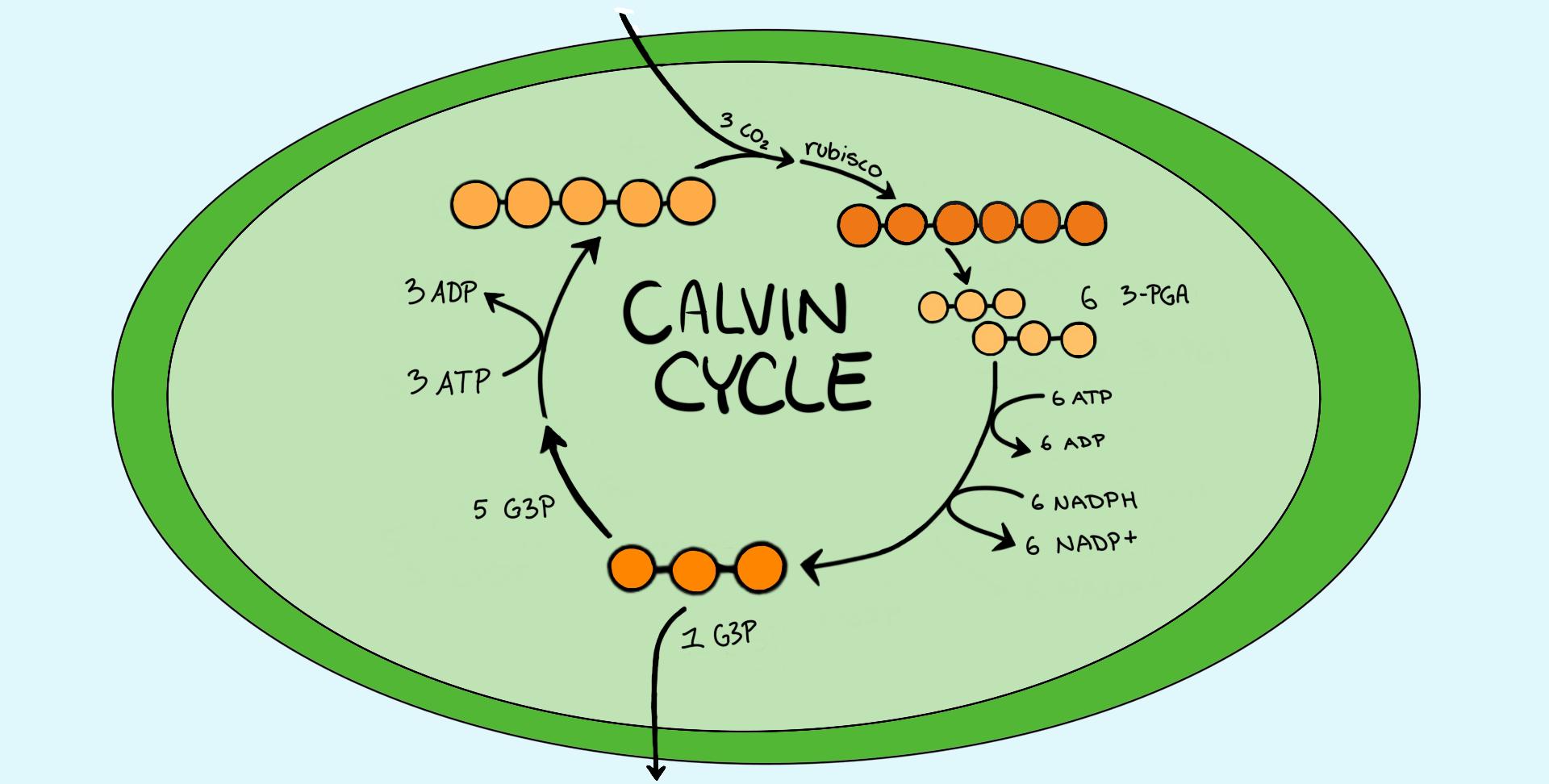
The Calvin Cycle, also known as the Calvin-Benson cycle or the C3 cycle, is a fundamental process in the field of biology that plays a crucial role in photosynthesis. Named after Melvin Calvin, who won the Nobel Prize in Chemistry for his groundbreaking work on this cycle, it is responsible for the conversion of carbon dioxide into glucose, the primary source of energy for living organisms.
Understanding the intricacies of the Calvin Cycle is not only important for students studying biology, but also for anyone interested in grasping the complex mechanisms behind photosynthesis and the sustainable production of energy. In this article, we will delve into 19 intriguing facts about the Calvin Cycle, shedding light on its key components, functions, and significance in the natural world. So get ready to embark on a fascinating journey through the inner workings of this remarkable biological process.
Key Takeaways:
- The Calvin Cycle, also known as the light-independent reactions of photosynthesis, is a vital process in plants and algae that converts carbon dioxide into glucose for energy and growth.
- Understanding the Calvin Cycle’s fascinating facts helps us appreciate its importance in balancing atmospheric carbon dioxide, supporting plant growth, and sustaining the global food web.
The Calvin Cycle was discovered by Melvin Calvin.
Melvin Calvin, an American chemist, conducted groundbreaking research on photosynthesis and elucidated the biochemical pathway known as the Calvin Cycle. For his contributions, he was awarded the Nobel Prize in Chemistry in 1961.
It takes place in the stroma of chloroplasts.
The Calvin Cycle occurs in the stroma, the fluid-filled region within chloroplasts. This is where the necessary enzymes and molecules are present to facilitate the various reactions of the cycle.
The Calvin Cycle is also called the C3 pathway.
Being a C3 pathway, the Calvin Cycle initially forms a three-carbon molecule called 3-phosphoglycerate (PGA) during carbon fixation.
It requires ATP and NADPH.
To power the reactions of the Calvin Cycle, ATP (adenosine triphosphate) and NADPH (nicotinamide adenine dinucleotide phosphate) generated in the light-dependent reactions of photosynthesis are utilized.
Rubisco is a key enzyme in the Calvin Cycle.
Rubisco, short for ribulose-1,5-bisphosphate carboxylase/oxygenase, is the enzyme responsible for catalyzing the initial step of carbon fixation by combining CO2 with a five-carbon molecule, ribulose-1,5-bisphosphate (RuBP).
It involves three major stages.
The Calvin Cycle can be divided into three stages: carbon fixation, reduction, and regeneration. Each stage consists of a series of enzyme-catalyzed reactions that lead to the eventual production of glucose.
The Calvin Cycle plays a crucial role in carbon dioxide uptake.
By converting carbon dioxide into glucose, the Calvin Cycle helps in the removal of carbon dioxide from the atmosphere and its incorporation into organic compounds.
It is an essential process for plant growth and development.
The Calvin Cycle supplies plants with the energy-rich molecules needed to support growth, reproduction, and other metabolic activities crucial for their survival.
Temperature affects the efficiency of the Calvin Cycle.
The rate of the Calvin Cycle’s reactions is influenced by temperature. Extreme temperature, both hot and cold, can negatively impact the efficiency of the cycle, potentially leading to reduced plant growth and productivity.
Photorespiration is a side reaction of the Calvin Cycle.
Under certain conditions, Rubisco can also catalyze an oxygenation reaction instead of a carboxylation reaction, resulting in the process called photorespiration. Photorespiration can reduce the efficiency of the Calvin Cycle.
The Calvin Cycle helps regulate Earth’s carbon balance.
By converting carbon dioxide into glucose, the Calvin Cycle plays a vital role in balancing the levels of atmospheric carbon dioxide, a greenhouse gas linked to climate change.
It operates in most plants and algae.
The Calvin Cycle is not limited to specific plant species or algae types. It is a fundamental process that occurs in the majority of plants and algae, allowing them to produce glucose and meet their energy needs.
Light intensity impacts the rate of the Calvin Cycle.
The rate of the Calvin Cycle is influenced by the intensity of light. Higher light intensity can lead to increased production of ATP and NADPH, accelerating the cycle, while low light can slow down the cycle.
The Calvin Cycle is an anabolic pathway.
The Calvin Cycle is an anabolic pathway, meaning it involves the synthesis of complex molecules from simpler molecules. In this case, it converts CO2, ATP, and NADPH into glucose.
The Calvin Cycle is a cyclic process.
As the name suggests, the Calvin Cycle is a cyclic process where the end molecule, RuBP, is regenerated to sustain the cycle for continuous glucose production.
It has important implications for crop productivity.
Understanding the mechanisms that regulate the Calvin Cycle is of great importance in improving crop productivity, as it influences the yield and quality of agricultural crops.
The Calvin Cycle is influenced by environmental factors.
Factors such as light availability, temperature, water availability, and nutrient availability can affect the operation and efficiency of the Calvin Cycle in plants and algae.
The Calvin Cycle can be studied using isotopic labeling techniques.
To gain further insights into the Calvin Cycle and its intermediates, isotopic labeling techniques can be employed. By using isotopes of carbon, researchers can track the movement of carbon atoms throughout the cycle.
The Calvin Cycle supports the global food web.
By producing glucose, the Calvin Cycle serves as a foundation for the global food web. Plants and algae, powered by this cycle, provide energy and nutrients to sustain the diverse organisms in different ecosystems.
The Calvin Cycle is undoubtedly a remarkable process that plays a central role in the lives of plants, algae, and ultimately all living organisms. Understanding the intricacies and fascinating facts about the Calvin Cycle helps us appreciate the importance of photosynthesis and the profound impact it has on our planet. Through this remarkable cycle, nature efficiently converts carbon dioxide into precious energy-rich molecules, supporting life as we know it.
Conclusion
The Calvin Cycle is a fascinating biochemical process that plays a crucial role in photosynthesis. It allows plants and other autotrophic organisms to convert carbon dioxide into energy-rich molecules like glucose. Understanding the intricacies of the Calvin Cycle is essential for unraveling the mysteries of plant biology and exploring ways to improve crop yields and mitigate climate change.
Through this article, we have uncovered 19 intriguing facts about the Calvin Cycle. From its discovery by Melvin Calvin to its intricate steps involving carbon fixation, reduction, and regeneration, the Calvin Cycle never fails to amaze with its elegance and efficiency. Its reliance on enzymes, carriers, and energy molecules highlights the intricate web of biochemical reactions that occur within plants.
By delving into the fascinating world of the Calvin Cycle, we gain a deeper appreciation for the complexity of life on Earth and the incredible adaptations that enable plants to thrive. The Calvin Cycle truly showcases the wonders of biology and reminds us of the intricate processes that occur within every plant cell.
FAQs
1. What is the Calvin Cycle?
The Calvin Cycle is a set of biochemical reactions that occur in the chloroplasts of plants and algae. It is part of the process of photosynthesis and is responsible for converting carbon dioxide into energy-rich molecules like glucose.
2. Who discovered the Calvin Cycle?
The Calvin Cycle was discovered by Melvin Calvin, an American biochemist, in the 1950s. He received the Nobel Prize in Chemistry in 1961 for his groundbreaking work on the cycle.
3. How does the Calvin Cycle work?
The Calvin Cycle consists of a series of enzymatic reactions that occur in three stages: carbon fixation, reduction, and regeneration. In carbon fixation, carbon dioxide is incorporated into a three-carbon compound called RuBP. This compound is then converted into carbohydrates through a series of reduction and regeneration reactions.
4. Why is the Calvin Cycle important?
The Calvin Cycle is vital for plants and other autotrophic organisms as it enables them to produce glucose and other energy-rich molecules necessary for growth and survival. It also helps remove carbon dioxide from the atmosphere, playing a crucial role in reducing greenhouse gas levels and mitigating climate change.
5. Are there any alternative pathways to the Calvin Cycle?
Yes, some plants, particularly in hot and dry environments, have evolved alternative pathways to the Calvin Cycle, such as the C4 and CAM pathways. These pathways have additional biochemical adaptations that enhance the efficiency of carbon dioxide fixation and minimize water loss.
6. Can the Calvin Cycle be targeted for crop improvement?
Yes, understanding the Calvin Cycle and its associated enzymes can help scientists develop strategies to improve crop yields and enhance photosynthetic efficiency. By manipulating the expression of key enzymes or optimizing the efficiency of carbon fixation, researchers aim to develop crops that are more resilient and productive.
Intrigued by the Calvin Cycle's role in photosynthesis? Keep exploring this fascinating process with our articles on mindblowing facts about the Calvin Cycle and astounding facts about light-independent reactions. Unravel more secrets of the Calvin Cycle's inner workings, and see how light-independent reactions contribute to this crucial process. Satisfy your curiosity and expand your knowledge of photosynthesis with these engaging reads!
Was this page helpful?
Our commitment to delivering trustworthy and engaging content is at the heart of what we do. Each fact on our site is contributed by real users like you, bringing a wealth of diverse insights and information. To ensure the highest standards of accuracy and reliability, our dedicated editors meticulously review each submission. This process guarantees that the facts we share are not only fascinating but also credible. Trust in our commitment to quality and authenticity as you explore and learn with us.


